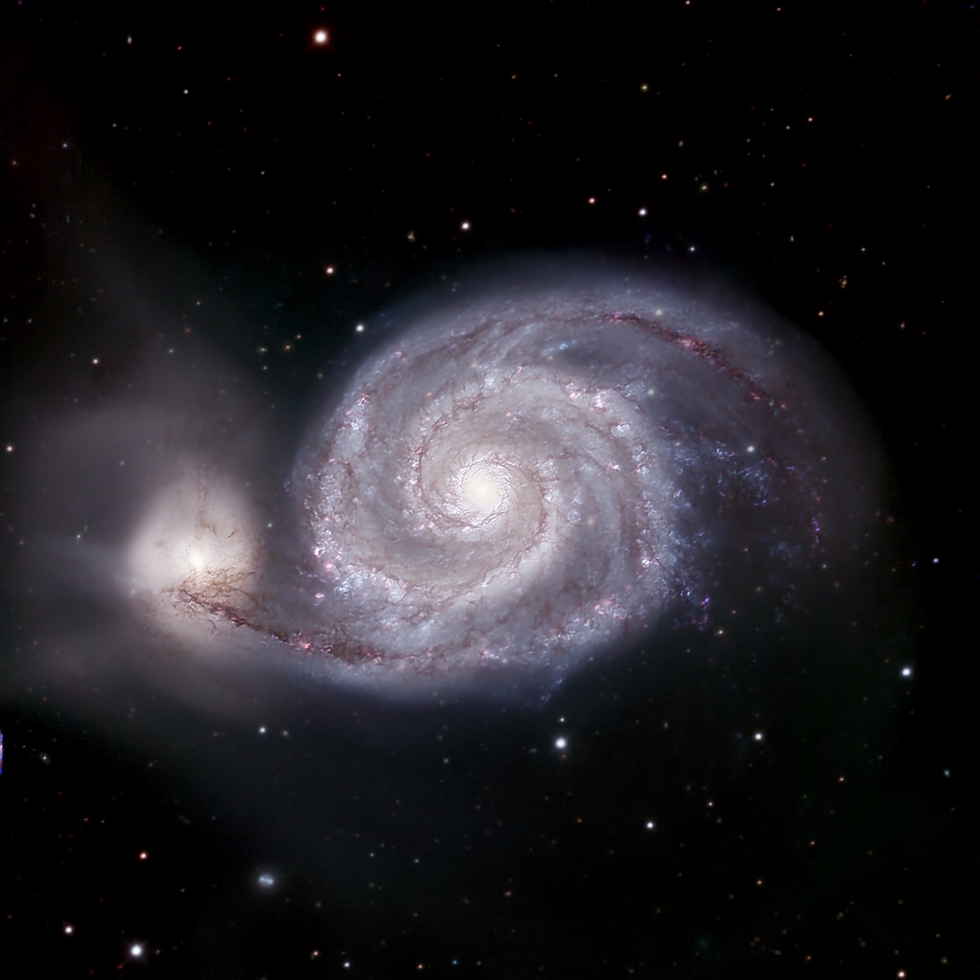whirlpool galaxy (Messier 51); Facts, Location, Type
- Home
- chevron_right
- Galaxies
- chevron_right
- whirlpool galaxy (Messier 51); Facts, Location, Type
Nestled within the vast expanse of our universe, the Whirlpool Galaxy stands as a testament to the mesmerizing beauty and complexity of the cosmos. Also known as Messier 51a, M51a, or NGC 5194, this spiral galaxy has captivated astronomers and space enthusiasts alike for centuries. In this exploration, we will delve into the depths of the Whirlpool Galaxy, unraveling its mysteries, examining its unique features, and understanding its significance in the cosmic tapestry.
Discovering the Whirlpool Galaxy
The Whirlpool Galaxy, located in the constellation Canes Venatici, was first discovered by Charles Messier on October 13, 1773. Its designation in the Messier Catalog, a compilation of astronomical objects, cements its place in the annals of celestial exploration. The Whirlpool Galaxy is a striking example of a grand design spiral galaxy, characterized by its well-defined arms spiraling outward from a bright nucleus.
Unveiling the Whirlpool Galaxy’s Structure and Type
At the heart of our exploration is understanding the structure and type of the Whirlpool Galaxy. Classified as a classic spiral galaxy, it features prominent spiral arms adorned with intricate dust lanes and regions of intense star formation. The grand design spiral classification places the Whirlpool Galaxy in the league of galaxies with well-defined arms and a central bar or nucleus.
Type of Galaxy: Spiral Splendor
The Whirlpool Galaxy’s classification as a spiral galaxy is significant. Spiral galaxies are known for their majestic arms, stellar nurseries, and distinct central bulge. This structure is a result of the gravitational interplay between stars, gas, and dark matter, orchestrating a cosmic dance that gives rise to the galaxy’s awe-inspiring form.
Facts That Illuminate the Whirlpool Galaxy’s Splendor
Distance and Proximity to Earth
The Whirlpool Galaxy is approximately 23 million light-years away from Earth, making it a relatively close neighbor in the vast cosmic neighborhood. This proximity allows astronomers to study its features with remarkable detail, providing insights into the dynamics of spiral galaxies and the broader cosmos.
Object Search: A Celestial Treasure Hunt
For amateur astronomers and stargazers, the Whirlpool Galaxy is a coveted object in the night sky. Located near the handle of the Big Dipper, it presents a celestial treasure hunt, inviting observers to venture beyond the familiar constellations and witness the splendor of Messier 51a through telescopic lenses.
James Webb Space Telescope: A Glimpse into the Future
The upcoming James Webb Space Telescope, poised to revolutionize our understanding of the universe, holds promise for enhancing our knowledge of the Whirlpool Galaxy. Its advanced capabilities in infrared observations will pierce through cosmic dust, unraveling the secrets hidden within the galaxy’s spiral arms and shedding light on the processes driving its evolution.
The Enigmatic Dance: Messier 51a and Its Satellite Galaxy
As we navigate deeper into the realms of the Whirlpool Galaxy, it’s crucial to acknowledge its cosmic dance with a companion galaxy, NGC 5195. Messier 51a and NGC 5195 engage in a gravitational interplay, a celestial waltz that has profound implications for their evolution.
Galactic Interaction: A Cosmic Ballet
The interaction between Messier 51a and NGC 5195 is not merely a visual spectacle but a dynamic process shaping the destinies of both galaxies. Tidal forces induced by their gravitational tango trigger bursts of star formation and sculpt the intricate patterns observed in their structures. This cosmic ballet provides astronomers with a unique opportunity to witness the transformative effects of galactic interactions.
Bridging Distances and Dimensions
Galactic Dimensions: Beyond the Observable
The Whirlpool Galaxy spans a considerable diameter of about 60,000 light-years. Its vast dimensions offer a canvas for astronomical observations, enabling scientists to explore the intricate details of its spiral arms, identify stellar nurseries, and discern the complex interplay of celestial forces shaping its form.
Interstellar Messengers: Cosmic Distances in Perspective
Light, the fastest traveler in the universe, takes approximately 23 million years to journey from the Whirlpool Galaxy to Earth. This staggering distance underscores the immense scales involved in cosmic measurements and prompts contemplation on the temporal and spatial dimensions of our cosmic neighborhood.
Planet Formation and Stellar Nurseries in the Whirlpool Galaxy
Diving into the heart of Messier 51a unveils a celestial spectacle—stellar nurseries where new stars are born, and planetary systems take shape. The Whirlpool Galaxy serves as a cosmic crucible, nurturing the formation of celestial bodies that populate its vast expanse.
Cosmic Cradles: Stellar Nurseries in Action
Within the Whirlpool Galaxy’s spiral arms, dense clouds of gas and dust act as cosmic cradles, giving birth to stars and planetary systems. These stellar nurseries, illuminated by the glow of newborn stars, contribute to the galaxy’s luminous tapestry, creating a visual feast for astronomers and igniting the curiosity of those peering into the cosmic abyss.
Conclusion: Navigating the Cosmic Whirlpool
In conclusion, the Whirlpool Galaxy, with its grand design spiral structure, gravitational dance with NGC 5195, and role as a stellar nursery, stands as a testament to the cosmic wonders that captivate our imagination. Its proximity, coupled with advancements like the James Webb Space Telescope, ensures that our journey into the depths of Messier 51a is far from over. As we gaze at the Whirlpool Galaxy from our vantage point in the cosmos, we are reminded of the boundless beauty and complexity that the universe holds.
Unlocking the secrets of the Whirlpool Galaxy requires a harmonious blend of technological innovation, astronomical curiosity, and a deep appreciation for the celestial ballet playing out in the cosmic theater. Whether you are an avid stargazer, an aspiring astronomer, or simply a curious soul pondering the mysteries of the universe, the Whirlpool Galaxy beckons, inviting you to peer into its spiral arms and witness the cosmic dance that unfolds across the vast expanse of space.
References:
Table of Contents
Recent Posts
- What is Gravity?
- whirlpool galaxy (Messier 51); Facts, Location, Type
- Astronomy; Definition, Types, History and Facts
- Draco Constellation; Facts, Myth, Location, Stars
- Cassiopeia Constellation: Facts, Myth, Location, Stars
- Zodiac Constellations; Facts, Stars, Symbols, Dates, Signs
- Atik Star Omicron Persei; +10 Facts, Myth, Features
- Algol Star β Persei; +10 Facts, Myth, Features
Suggest Posts
- What is Gravity?
- whirlpool galaxy (Messier 51); Facts, Location, Type
- Astronomy; Definition, Types, History and Facts
- Draco Constellation; Facts, Myth, Location, Stars
- Cassiopeia Constellation: Facts, Myth, Location, Stars
- Zodiac Constellations; Facts, Stars, Symbols, Dates, Signs
- Atik Star Omicron Persei; +10 Facts, Myth, Features
- Algol Star β Persei; +10 Facts, Myth, Features
Categories

Nazanin Teymoori
Hi there, I am Nazanin, a member of the Aquilae Constellation team. And also the author of all the texts of this blog.
I am delighted that after many years of great interest in astronomy, I launched this website with the help of our professional team. We have many challenges ahead of us, but we promise ourselves that we will overcome everything.
I love astronomy So Let's go





